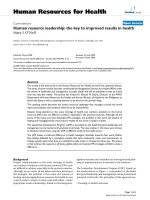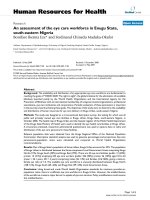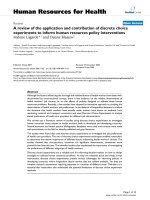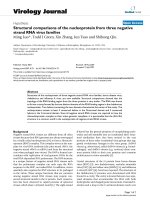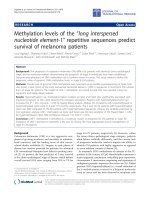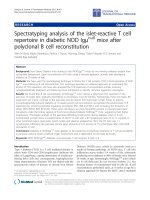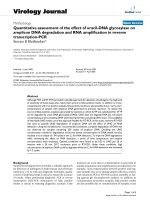Báo cáo sinh học: " Genetic characterisation of the recent foot-and-mouth disease virus subtype A/IRN/2005" pptx
Bạn đang xem bản rút gọn của tài liệu. Xem và tải ngay bản đầy đủ của tài liệu tại đây (2.43 MB, 12 trang )
BioMed Central
Page 1 of 12
(page number not for citation purposes)
Virology Journal
Open Access
Research
Genetic characterisation of the recent foot-and-mouth disease virus
subtype A/IRN/2005
Joern Klein
1
, Manzoor Hussain
2
, Munir Ahmad
2
, Preben Normann
1
,
Muhammad Afzal
3
and Soren Alexandersen*
1
Address:
1
National Veterinary Institute, Technical University of Denmark, Lindholm, DK-4771 Kalvehave, Denmark,
2
Food and Agriculture
Organization of the United Nations – Pakistan, NARC, Park Road, PK-45500, Pakistan and
3
Ministry of Food, Agriculture & Livestock Pakistan,
Livestock wing, PK-44000, Pakistan
Email: Joern Klein - ; Manzoor Hussain - ; Munir Ahmad - ;
Preben Normann - ; Muhammad Afzal - ; Soren Alexandersen* -
* Corresponding author
Abstract
Background: According to the World Reference Laboratory for FMD, a new subtype of FMDV serotype A was
detected in Iran in 2005. This subtype was designated A/IRN/2005, and rapidly spread throughout Iran and moved
westwards into Saudi Arabia and Turkey where it was initially detected from August 2005 and subsequently caused major
disease problems in the spring of 2006. The same subtype reached Jordan in 2007. As part of an ongoing project we have
also detected this subtype in Pakistan with the first positive samples detected in April 2006.
To characterise this subtype in detail, we have sequenced and analysed the complete coding sequence of three subtype
A/IRN/2005 isolates collected in Pakistan in 2006, the complete coding sequence of one subtype A/IRN/2005 isolate
collected during the first outbreak in Turkey in 2005 and, in addition, the partial 1D coding sequence derived from 4
epithelium samples and 34 swab-samples from Asian buffaloes or cattle subsequently found to be infected with the A/
IRN/2005 subtype.
Results: The phylogenies of the genome regions encoding for the structural proteins, displayed, with the exception of
1A, distinct, serotype-specific clustering and an evolutionary relationship of the A/IRN/2005 sublineage with the A22
sublineage. Potential recombination events have been detected in parts of the genome region coding for the non-
structural proteins of FMDV.
In addition, amino acid substitutions have been detected in the deduced VP1 protein sequence, potentially related to
clinical or subclinical outcome of FMD.
Indications of differential susceptibility for developing a subclinical course of disease between Asian buffaloes and cattle
have been detected.
Furthermore, hitherto unknown insertions of 2 amino acids before the second start codon, as well as sublineage specific
amino acids have been detected in the genome region encoding for the leader proteinase of A/IRN/2005 sublineage.
Conclusion: Our findings indicate that the A/IRN/2005 sublineage has undergone two different paths of evolution for
the structural and non-structural genome regions.
The structural genome regions have had their evolutionary starting point in the A22 sublineage. It can be assumed that,
due to the quasispecies structure of FMDV populations and the error-prone replication process, advantageous mutations
in a changed environment have been fixed and lead to the occurrence of the new A/IRN/2005 sublineage.
Published: 15 November 2007
Virology Journal 2007, 4:122 doi:10.1186/1743-422X-4-122
Received: 9 October 2007
Accepted: 15 November 2007
This article is available from: />© 2007 Klein et al; licensee BioMed Central Ltd.
This is an Open Access article distributed under the terms of the Creative Commons Attribution License ( />),
which permits unrestricted use, distribution, and reproduction in any medium, provided the original work is properly cited.
Virology Journal 2007, 4:122 />Page 2 of 12
(page number not for citation purposes)
Together with this mechanism, recombination within the non-structural genome regions, potentially modifying the
virulence of the virus, may be involved in the success of this new sublineage.
The possible origin of this recombinant virus may be a co-infection with Asia1 and a serotype A precursor of the A/IRN/
2005 sublineage potentially within Asian Buffaloes, as these appears to relatively easy become infected, but usually
without developing clinical disease and consequently showing not a strong acute inflammatory immune response against
a second FMDV infection.
Background
Foot-and-mouth disease (FMD) is a highly communica-
ble and economically important disease caused by foot-
and-mouth disease virus (FMDV). Animals that can be
affected include cattle, swine, sheep, goats, wild pigs, wild
ruminants and buffaloes [1]. FMDV is a positive sense sin-
gle-stranded RNA virus (genus Aphthovirus, family Picorna-
viridae) occurring in seven serotypes, O, A, C, Asia1, SAT
1, SAT 2 and SAT 3, each with a wide spectrum of anti-
genic and epidemiological different subtypes. The wide
diversity is considered a consequence of the high muta-
tion rate, quasi-species dynamics [2] and recombination
[3,4].
Within the seven serotypes, serotype A displays the great-
est number of newly occurring subtypes, which makes the
control by vaccination very difficult [5].
During 2005, a new FMDV A subtype, A/IRN/2005,
spread throughout Iran and moved westwards into Saudi
Arabia, Turkey and in 2007 reached Jordan [6]. In 2006,
we have also detected this subtype in Pakistan [7]. This
particular FMDV subtype has proven to be highly virulent
and has caused severe disease in all ages of cattle [8].
Serum neutralization assays demonstrated a closer rela-
tionship to A22 than to other serotype A subtypes [9] and
the World Reference Laboratory as well as the FAO Euro-
pean Commission for the control of FMD recommend, in
the absence of an homologous vaccine strain, the use of
the widely available A22 Iraq strain as vaccine [6].
For an ongoing study in Landhi Cattle Colony (LCC),
Pakistan, we have collected more than thousand swab-
samples from randomly selected Asian buffaloes and cat-
tle without clinical signs of FMD, as well as a number of
epithelium samples from clinical FMD cases. Landhi cat-
tle colony consists of approximately 2000 farms with a
total population of approximately 300000 animals, of
which 90% are Asian buffalos and furthermore a high
number of free ranging sheep and goats. FMD vaccination
is applied to a high degree in the cattle and buffalo popu-
lation, using legally purchased and black market vaccines.
We have sequenced and analysed the complete coding
sequence of three A/IRN/2005 isolates collected in Paki-
stan in 2006 and also the complete coding sequence of
one isolate collected during the first outbreak in Turkey in
2005. In addition, we have analysed partial 1D sequences
derived from 4 vesicular epithelium samples and from 34
mouth swabs collected in Pakistan from Asian buffaloes
and cattle found subsequently infected with this subtype.
Results
Phylogenetic inference
The complete coding sequence (CDS) of four A/IRN/
2005-like isolates, three originating from Karachi, Paki-
stan (Pakistan1, Pakistan3, Pakistan5) and collected in
spring 2006, and in addition, the first recognized out-
break of A/IRN/2005 in Turkey in spring 2005, Tur-
key(WRL), have been compared with sequences
published in Genbank (Table 1). Phylogenies have been
inferred for the complete CDS, as well as for each protein
coding genome-region (a schematic drawing of the FMDV
genome is shown in Additional file 1).
Figure 1 displays the phylogeny of the complete CDS of
the three serotypes O, Asia1 and A, showing the close rela-
tionship of the A/IRN/2005 subtype to the A22 and A28
subtypes, circulating in the Middle East region. The A/
IRN/2005 subtype shares a common ancestor with A
Iran105 which originated from Iran in 1998.
Figures 2 and 3 displays the inferred phylogenies of the
genome regions coding for the nonstructural proteins.
The phylogeny of 2B place the A/IRN/2005 sublineage in
close relation to an A15 lineage from Thailand isolated in
1960 and in further relation to A16 Belem, isolated in
1959, A12 Valle, isolated in 1932 and O5 India, isolated
in 1962. The inferred phylogeny of the 2C genome region
displays a clear relationship between the A/IRN/2005 sub-
lineage and an Asia1 lineage originating from the Leba-
non, as well as an relation with the Indian vaccine strain
for Asia1 India97 and O1 Manisa. In both phylogenies
non-serotype specific grouping can be seen between some
Asia1, A and O sublineages, however the PanAsia sublin-
eage of serotype O and the A22, A23 and A28 sublineage
of serotype A are monophyletic, i.e. it consists of an
inferred common ancestor. The latter sublineages are well
separated from A/IRN/2005.
Virology Journal 2007, 4:122 />Page 3 of 12
(page number not for citation purposes)
The phylogeny of the coding sequence of the 3AB non-
structural proteins, which are important for RNA replica-
tion, displays the A/IRN/2005 sublineage as a
monophyletic group, but with an relation to a group of at
least 31 years old isolates, consisting of serotypes O, A and
C. Members of the latter are also in relation to A/IRN/
2005 sublineage within the 2B phylogeny.
Also the phylogeny of the coding sequence for the 3C pro-
tease, present the A/IRN/2005 sublineage as a mono-
phyletic group, sharing a common ancestor with the
PanAsia sublineage of serotype O and the Indian vaccine
strain for Asia1 India97. The 3C phylogeny shows a
number of non-serotype specific clustering.
Table 1: Selection of isolates used in this study
accession-no. serotype isolate year of isolation published by
EF117837 A Pakistan3 2006 this study
EF494486
A Turkey(WRL) 2005 this study
EF494487
A Pakistan1 2006 this study
AY593791
AIran1051998[3]
EF494488
A Pakistan5 2006 this study
AY593803
A Venceslau 1976 [3]
AY593787
A Bagge77 1977 [3]
AY593752
A12 Valle 1932 [3]
AY593755
A15 Thailand 1960 [3]
AY593756
A16 Belem 1959 [3]
AY593765
A22 Turkey 1965 [3]
AY593763
A22 Iraq64 1964 [3]
AY593764
A22 Iraq70 1970 [3]
AY593762
A22 Iraq95 1995 [3]
AY593763
A22 Iraq64 1964 [3]
AY593765
A22 Turkey66 1966 [3]
AY593766
A23 Kenya 1965 [3]
DQ767862
A Iran 2006 unpublished
AY593772
A28 Turkey 1972 [3]
AY593800
Asia1 Leb83 1983 [3]
AY687333
Asia1 India01 2001 [13]
AY593798
Asia1 Leb89 1983 [3]
AY593799
Asia1 Leb4 1983 [3]
AY304994
Asia1 India63 vaccine [3]
AY687334
Asia1 India97 vaccine [3]
AY593807
C3 Resende 1955 [3]
DQ404179
OUK2001[20]
DQ404168
OUK2001[20]
DQ404180
OUK2001[20]
EF611987
O Uganda 2006 this study
AY593834
OIran1966[3]
DQ404163
OUK2001[20]
AJ539138
O CHA99 1999 [3]
AJ539137
OTAW21999[3]
AJ539140
OSAR1999[3]
AJ539139
OSKR2000[3]
AF377945
OSKR2000[3]
AB079061
OJPN2000[3]
AJ539136
OTAW21999[3]
AF506822
OCHA1999[3]
AJ633821
OFRA2001[3]
AY333431
ONY2000[3]
AF506822
OCHA1999[3]
AY593824
O1 SKR 2000 [3]
AF189157
O1 Geshure unknown [3]
AY593823
O1 Manisa 1969 [3]
AY593821
O1 Caseros 1967 [3]
AF283435
O5 India 2000 [21]
AY593828
O5 India 1962 [3]
Virology Journal 2007, 4:122 />Page 4 of 12
(page number not for citation purposes)
Bayesian phylogenetic analysis of the complete coding sequence of the A/IRN/2005 sublineage (red) and related published sequences (black)Figure 1
Bayesian phylogenetic analysis of the complete coding sequence of the A/IRN/2005 sublineage (red) and
related published sequences (black). Numbers on the nodes indicate clade credibility values.
0.1
EF611987 Uganda 2006
AY593828 O5 India
AY593823 O1 Manisa
1.00
AJ539138 O CHA99
AF506822 O CHA99
AY593824 O1 SKR
AJ539136 O TAW99
AJ539137 O TAW99
AB079061 O JPN 2000
AJ539140 O SAR 2000
DQ404180 O UKG 2001
AJ539141 O UKG 2001
AJ633821 O FRA 2001
DQ404179 O UKG 2001
DQ404176 O UKG 2001
DQ404168 O UKG 2001
DQ404171 O UKG 2001
1.00
AY593821 O1 Caseros
AY304994 Asia1 India63
AY687333 Asia1 India01
AY687334 Asia1 India97
1.00
AY593799 Asia1 Leb4
AY593800 Asia1 Leb83
AY593798 Asia1 Leb89
1.00
1.00
AY593755 A15 Thailand
AY593766 A23 Kenya
AY593752 A12 Valle
AY593756 A16 Belem
1.00
1.00
1.00
AY593772 A28 Turkey
AY593765 A22 Turkey
AY593763 A22 Iraq64
AY593762 A22 Iraq95
AY593764 A22 Iraq70
1.00
AY593791 A Iran105
EF494488 Pakistan5 2006
EF494486 Turkey (WRL) 2005
EF117837 Pakistan3 2006
EF494487 Pakistan1 2006
1.00
1.00
1.00
1.00
1.00
1.00
1.00
1.00
O
A
Asia1
Virology Journal 2007, 4:122 />Page 5 of 12
(page number not for citation purposes)
Bayesian phylogenetic analysis of the genome regions 2B, 2C, 3AB and 3C, coding for non-structural proteins of the A/IRN/2005 sublineage (red) and related published sequences (black)Figure 2
Bayesian phylogenetic analysis of the genome regions 2B, 2C, 3AB and 3C, coding for non-structural proteins
of the A/IRN/2005 sublineage (red) and related published sequences (black). Numbers on the nodes indicate clade
credibility values.
0.1
EF611987 Uganda 2006
AJ539138 O Tibet CHA 99
AF506822O China 1 99
1.00
AY593824 O1 SKR 00
AJ539136 O TAW 2 99
AJ539137 O TAW 2 99
1.00
AB079061 O JPN 2000
DQ404171 O UKG 4569 2001
DQ404180O UKG 11 2001
DQ404176O UKG 150 2001
0.50
AJ539140O SAR 19 2000
AJ633821 O FRA 1 2001
0.50
DQ404168 O UKG 9011 2001
AJ539141 O UKG 35 2001
DQ404179 O UKG 126 2001
0.50
0.50
1.00
0.50
AY593772 A28 Turkey
AY593765 A22 Turkey
AY593763 A22 Iraq64
AY593762 A22 Iraq95
AY593764 A22 Iraq70
0.50
1.00
1.00
1.00
AY593766 A23 Kenya
AY687333 Asia1 India01
0.50
AY593823 O1 Manisa
AY593821 O1 Caseros
AY687334 Asia1 India97
0.50
AY304994 Asia1 India63
AY593791 A Iran105
AY593799 Asia1 Leb4
AY593800 Asia1 Leb83
AY593798 Asia1 Leb89
1.00
1.00
1.00
1.00
0.50
AY593828 O5 India
AY593756 A16 Belem
AY593752 A12 Valle
1.00
AY593755 A15 Thailand
0.50
1.00
0.50
1.00
0.50
0.50
0.50
0.50
1.00
0.50
2B
3AB
0.1
EF611987 Uganda 2006
AY593823 O1 Manisa
AY687334 Asia1 India97
0.50
AY593798 Asia1 Leb89
AY593800 Asia1 Leb83
AY593799 Asia1 Leb4
1.00
1.00
1.00
1.00
1.00
1.00
0.50
AY593755 A15 Thailand
AY593752 A12 Valle
AY687333 Asia1 India01
AY593821 O1 Caseros
AY593756 A16 Belem
1.00
0.50
0.50
0.50
AY593791 A Iran105
AY304994 Asia1 India63
AY593828 O5 India
1.00
AY593766 A23 Kenya
AY593772 A28 Turkey
AY593765 A22 Turkey
AY593762 A22 Iraq95
AY593763 A22 Iraq64
AY593764 A22 Iraq70
0.50
1.00
1.00
1.00
0.50
0.50
AB079061 O JPN 2000
AY593824 O1 SKR00
AJ539136 O TAW 2 99
AJ539137 O TAW 2 99
AJ539138 O CHA 99
AF506822 O China 1 99
AJ539140 O SAR 19 2000
AJ539141 O UKG 35 2001
AJ633821 O FRA 1 2001
DQ404179 O UKG 126 2001
DQ404168 O UKG 9011 2001
DQ404171 O UKG 4569 2001
DQ404180 O UKG 11 2001
DQ404176 O UKG 150 2001
0.50
0.50
2C
3C
EF494488 Pakistan5 2006
EF494488 Pakistan5 2006
EF494486 Turkey (WRL) 2005
EF494486 Turkey (WRL) 2005
EF117837 Pakistan3 2006
EF117837 Pakistan3 2006
EF494487 Pakistan1 2006
EF494487 Pakistan1 2006
O
O
A
ASIA1
ASIA1
ASIA1, A, O
A
A22
O
O
Asia1, A, O
A
A
Asia1, A
0.1
EF611987 Uganda 2006
AY593823 O1 Manisa
AY687333 Asia1 India01
AY593799 Asia1 Leb4
AY593798 Asia1 Leb89
AY593800 Asia1 Leb83
1.00
1.00
0.50
0.50
AY593765 A22 Turkey66
AY593764 A22 Iraq70
AY593763 A22 Iraq64
AY593762 A22 Iraq95
1.00
1.00
1.00
AY304994 Asia1 India63
AY593828 O5 India
1.00
AF506822 O CHA 99
AJ539138 O CHA 99
1.00
AY593824 O1 SKR 00
AJ539136 O TAW 2 99
AY333431 O NY 00
1.00
AB079061 O JPN 2000
AJ539140 O SAR 19 2000
DQ404169 O UKG 7038 2001
AJ633821 O FRA 1 2001
DQ404180 O UKG 11 2001
0.50
0.50
1.00
1.00
0.50
0.50
1.00
1.00
AY687334 Asia1 India97
AY593791 A Iran105
EF494488 Pakistan5 2006
EF494486 Turkey (WRL) 2005
EF494487 Pakistan1 2006
EF117837 Pakistan3 2006
1.00
1.00
1.00
AY593766 A23 Kenya
AY593752 A12 Valle
AY593803 A Venceslau
0.50
AY593787 A Bagge77
AY593821 O1 Caseros
AY593756 A16 Belem
AY593807 C3 Resende
1.00
1.00
1.00
1.00
1.00
0.50
0.50
0.50
0.50
0.50
0.1
EF611987 Uganda 2006
AY593800 Asia1 Leb83
AY593798 Asia1 Leb89
AY593799 Asia1 Leb4
0.50
1.00
AY593823 O1 Manisa
AY687334 Asia1 India97
AY593766 A23 Kenya
AY593765 A22 Turkey66
AY593762 A22 Iraq95
AY593764 A22 Iraq70
AY593763 A22 Iraq64
0.50
1.00
1.00
0.50
AY593791 A Iran105
AY304994 Asia1 India63
AY593828 O5 India
1.00
1.00
AY593787 A Bagge77
AY593807 C3 Resende
0.50
AY593821 O1 Caseros
AY593756 A16 Belem
AY593803 A Venceslau
0.50
1.00
1.00
AY593752 A12 Valle
EF494488 Pakistan5 2006
EF494486 Turkey (WRL) 2005
EF494487 Pakistan1 2006
EF117837 Pakistan3 2006
1.00
1.00
1.00
AY687333 Asia1 India01
AJ539136 O TAW 2 99
AJ539138 O CHA 99
0.50
AY333431 O NY 00
AY593824 O1 SKR 00
0.50
1.00
DQ404176 O UKG 150 2001
DQ404168 O UKG 9011 2001
AJ633821 O FRA 1 2001
AJ539140 O SAR 19 2000
DQ404171 O UKG 2001
DQ404180 O UKG 11 2001
1.00
1.00
1.00
1.00
0.50
0.50
1.00
0.50
1.00
0.50
Virology Journal 2007, 4:122 />Page 6 of 12
(page number not for citation purposes)
The phylogeny of the coding sequence for the RNA-
dependent RNA polymerase 3D, displays the A/IRN/2005
sublineage as an monophyletic group, sharing at one
point of time a common ancestor with the Panasia lineage
of serotype O and again with the previously mentioned
group of at least 31 years old isolates, as well as with the
A Iran105 and Asia1 India01 isolates.
The cladogram of the complete Leader protease coding
region present the A/IRN/2005 sublineage most related to
the A22/A28 lineages, but still with a clear evolutionary
distance (see Additional file 2).
The phylogenies of the genome regions encoding for the
structural proteins (see Additional file 3), display, with
the exception of 1A, distinct, serotype-specific clustering.
The A/IRN/2005 sublineage shares a common ancestor
with A Iran105, isolated during 1998 in Iran, within the
phylogenies for 1A to 1C. In these inferred phylogenies
the A/IRN/2005 sublineage is also in close relationship to
the A22 lineage. However, the phylogenetic analysis of the
1D genome region (Figure 4), encoding for the VP1 pro-
tein, shows that the A/IRN/2005 sublineage clusters
together with the A/IRN/99 sublineage, whereas A
Iran105 clusters together with the A/IRN/96 sublineage.
The A22 sublineage is here well separated from the A/IRN/
2005 sublineage.
Amino acid comparison of the partial VP1 surface protein
Figure 5 shows the alignment of the deduced amino acid
sequences of the immuno-dominant residues of the VP1
surface protein, including the GH-loop. The alignment
consist only of isolates belonging to the FMDV A/IRN/
2005 sublineage, collected in Karachi, Southern Pakistan
(with exception of Turkey (WRL) and an Iranian isolate
from 2006, DQ767862), but with three different sam-
pling strategies. The first group consists of samples from
Bayesian phylogenetic analysis of the genome regions 3D and L
ab
, coding for non-structural proteins of the A/IRN/2005 sublin-eage (red) and related published sequences (black)Figure 3
Bayesian phylogenetic analysis of the genome regions 3D and L
ab
, coding for non-structural proteins of the A/
IRN/2005 sublineage (red) and related published sequences (black). Numbers on the nodes indicate clade credibility
values. The inferred phylogeny of the L
ab
genome region is, for better legibility, displayed as cladogram.
0.1
EF611987 Uganda 2006
AY593766 A23 Kenya
AY593765 A22 Turkey66
AY593763 A22 Iraq64
AY593764 A22 Iraq70
AY593762 A22 Iraq95
1.00
1.00
1.00
1.00
AY593823 O1 Manisa
AY687334 Asia1 India97
AY593799 Asia1 Leb4
AY593798 Asia1 Leb89
AY593800 Asia1 Leb83
0.50
1.00
1.00
EF494488 Pakistan5 2006
EF494486 Turkey (WRL) 2005
EF494487 Pakistan1 2006
EF117837 Pakistan3 2006
1.00
1.00
1.00
AY593828 O5 India
AY593752 A12 Valle
AY593803 A Venceslau
AY593787 A Bagge77
AY593756 A16 Belem
AY593807 C3 Resende
AY593821 O1 Caseros
1.00
1.00
1.00
1.00
1.00
1.00
AY593791 A Iran105
AY687333 Asia1 India01
AY593824 O1 SKR 00
AF506822 O CHA 99
AJ539138 O CHA 99
1.00
AY333431 O NY 00
AJ539136 O TAW 2 99
AJ539137 O TAW 2 99
1.00
AB079061 O JPN 2000
AJ539140 O SAR 19 2000
DQ404180 O UKG 11 2001
DQ404176 O UKG 150 2001
AJ633821 O FRA 1 2001
DQ404160 O UKG 2001
DQ404168 O UKG 9011 2001
DQ404169 O UKG 7038 2001
DQ404171 O UKG 4569 2001
0.50
1.00
1.00
1.00
1.00
0.50
1.00
1.00
EF611987 Uganda 2006
AY593823 O1 Manisa
AF283435 O5 India
AY593828 O5 India
1.00
1.00
EF494488 Pakistan5 2006
EF494486 Turkey (WRL) 2005
EF494487 Pakistan1 2006
EF117837 Pakistan3 2006
1.00
1.00
1.00
AY593772 A28 Turkey
AY593765 A22 Turkey66
AY593762 A22 Iraq95
AY593763 A22 Iraq64
AY593764 A22 Iraq70
0.50
1.00
0.50
0.50
1.00
0.50
AY593834 O Iran 1966
AY593791 A Iran105
AY687333 Asia1 India01
0.50
0.50
AY593766 A23 Kenya
AY593755 A15 Thailand
AY593752 A12 Valle
AY593756 A16 Belem
1.00
0.50
1.00
AY304994 Asia1 India63
AF207521 Asia1 India
AF227965 Asia1 India63
0.50
1.00
AY593799 Asia1 Leb4
AY593798 Asia1 Leb89
AY593800 Asia1 Leb83
0.50
1.00
1.00
0.50
0.50
AF189157 O1 Geshure
AY687334 Asia1 India97
1.00
AJ539138 O CHA 99
AF506822 O CHA 99
AJ539139 O SKR 2000
AY593824 O1 SKR 00
1.00
AF377945 O SKR 2000
AY333431 O NY 00
0.50
AB079061 O JPN 2000
AJ539140 O SAR 19 2000
AJ633821 O FRA 1 2001
DQ404179 O UK 2001
0.50
DQ404162 O UK 2001
DQ404163 O UK 2001
DQ404177 O UK 2001
0.50
0.50
1.00
1.00
1.00
0.50
0.50
0.50
1.00
1.00
A
A
Asia1
Asia1
O
O
O
3D
L
ab
Virology Journal 2007, 4:122 />Page 7 of 12
(page number not for citation purposes)
Bayesian phylogenetic analysis of the 1D genome region of the A/IRN/2005 sublineage (red) and related published sequences (black)Figure 4
Bayesian phylogenetic analysis of the 1D genome region of the A/IRN/2005 sublineage (red) and related pub-
lished sequences (black). Numbers on the nodes indicate clade credibility values.
0.1
Uganda2006
AY593823 O1 Manisa
AY593828 O5 India
AY593824 O1 SKR85
AJ539137 O TAW 2 99
AJ539136 O TAW 2 99
AJ539138 O CHA99
AF506822 O CHA99
AB079061 O JPN 2000
AJ539140 O SAR 19 2000
DQ404179 O UKG 126 2001
DQ404176 O UKG 150 2001
AJ633821 O FRA 1 2001
DQ404168 O UKG 9011 2001
DQ404171 O UKG 4569 2001
AJ539141 O UKG 35 2001
DQ404180 O UKG 11 2001
AY593821 O1 Caseros
AY304994 Asia1 India63
AY687333 Asia1 India01
AY687334 Asia1 India97
AY593800 Asia1 Leb83
AY593798 Asia1 Leb89
AY593799 Asia1 Leb4
AF390612 A India88
AF390652 A India97
AF390615 A India94
AF390622 A India99
AF390593 A India99
AF390605 A India99
AF390623 A India99
AF390659 A India2001
AF390630 A India99
AF390626 A India99
AF390638 A India99
AF390636 A India99
AF390672 A India93
AF390640 A India99
AF390637 A India99
AF390641 A India88
AF390608 A India90
AF390657 A India88
DQ767862 Iran06
1.00
DQ767858 A Iran02
AY898962 A Iran
AY370770 A Iran
DQ767860 A Iran04
DQ296550 A Igdir Turkey99
DQ296544 A Kayseri Turkey00
DQ296545 A Erzurum Turkey
DQ296548 A Afyon Turkey
DQ296540 A Turkey
DQ296541 A Afyon Turkey
DQ296539 A Afyon Turkey
1.00
AF204108 A22 India
AF390645 A India88
AY593755 A15 Thailand
AY593766 A23 Kenya
AY593752 A12 Valle
AY593756 A16 Belem
1.00
AY593772 A28
AY593765 A22 Turkey
AY593762 A22 Iraq95
AY593763 A22 Iraq64
AY593764 A22 Iraq70
1.00
AF390635 A India93
DQ296543 A Aydin Turkey
DQ296542 A Kutahya Turkey
DQ296536 A Burdur Turkey
AY593791 A Iran105
AF390628 A India8
AF390606 A India93
AF390673 A India
AF390668 A India2000
AF390646 A India2000
AF390643 A India2000
AF390648 A India2000
AF390614 A India2000
AF390624 A India2001
AF390665 A India2000
AF390599 A India2000
AF390666 A India2000
1.00
0.50
0.50
1.00
1.00
1.00
1D
A
O
Asia1
DQ767862 Iran06
EF494488 Pakistan5 2006
EF494486 Turkey (WRL) 2005
EF494487 Pakistan1 2006
EF117837 Pakistan3 2006
A/IRN/99
A/IRN/96
Virology Journal 2007, 4:122 />Page 8 of 12
(page number not for citation purposes)
animals which showed no indication of acute FMD; those
animals are randomly selected from randomly selected
herds. If, during this sampling, animals with healing FMD
lesions were detected, then those samples were assembled
to group 2, subclinically infected animals, with a recent
outbreak history on the farm. The last group consists of
targeted collected epithelium samples from animals with
acute FMD.
All isolates, except four (Pakistan1, Pakistan3, Pakistan5
and Turkey (WRL)), have been directly sequenced, with-
out cell culture propagation of the virus.
Out of the group of randomly selected isolates from sub-
clinically infected animals it can be seen that all have the
integrin binding motif 'RGDLGPL' and threonine at resi-
due 193 in common. Sequence information from isolates
collected from a farm with recent (1–2 weeks) clinical out-
break, but samples from subclinically infected animals,
displayed the integrin binding motif 'RGDLGSL' and an
alanine at residue 193, as well as a serine at residue 197 in
common. Sequences from clinical affected animals dis-
played a proline at residue 138 and asparagine at residue
142, as well as alanine at position 193.
Of those isolates, where the virus has been propagated in
cell culture two display alanine at residue 57 and one
(EF494488 Pakistan5) a 'RGDLGSL' integrin binding
motif, whereas the others in this group have an
'RGDLGPL' motif.
Amino acid comparison of the Leader protease
Figure 6 displays the alignment of the deduced amino acid
sequence of the first 96 residues of the FMDV Leader pro-
tease from the A/IRN/05 sublineage together with pub-
lished sequences. The alignment shows a serotype-specific
distribution (see also Figure 3), however the A/IRN/2005
sublineage is unique with an insertion of two amino
Alignment of the deduced amino acid sequences of the immuno-dominant residues of the VP1 surface protein, including the GH-loopFigure 5
Alignment of the deduced amino acid sequences of the immuno-dominant residues of the VP1 surface protein, including the
GH-loop.
randomly selected samples
from sub-clinically infected animals
samples from farms with recent
outbreaks, collected from
sub-clinically infected animals
epithelium samples from clinically
infected animals
epithelium samples from clinically
infected animals
(cell culture propagated)
146 156 166 176 186 196 206
cell culture sample from WRL
sequence published in Genbank
Virology Journal 2007, 4:122 />Page 9 of 12
(page number not for citation purposes)
acids, arginine and threonine, before the second start
codon, and a phenylalanine, instead of tyrosine, at resi-
due 44. The sublineage shows also specific amino acids at
residues 13, 21, 27 and 86, namely glutamine, isoleucine,
glutamine and glutamine.
Virulence and Host species
Out of nine isolates, collected from clinically affected ani-
mals, seven (78%) have been derived from cattle (Bos tau-
rus) and two (22%) from Asian buffalo (Bubalus bubalis).
In contrast twenty-four (89%) out of twenty-seven iso-
lates from sub-clinically infected animals, originate from
Asian Buffalo. This means that the proportion of clinically
affected animals in the bovine species is 0.7 and in buffalo
is 0.1. By comparing these proportions with each other
and applying a two-sample t-test, the t-statistic was signif-
icant at the 0.05 critical alpha level, t(96) = 3.134, p =
0.0023. Therefore, it can be concluded that the difference
in the proportion of clinically affected animals in the
bovine species and in Asian Buffalo is significant. This dif-
ference is also supported by personal observation by the
authors, as well as the experience of the local veterinari-
ans.
Discussion
A major question within the epidemiology of FMDV sero-
type A is why so many new lineages so regularly appear
and why there is such a great antigenic diversity within
this serotype [5]. Frequent recombinations [10], as well as
long time circulation in poorly monitored areas and spe-
cies [5], have been mentioned as an explanation for this
characteristic.
This work shows that both factors may have contributed
to the appearance of sublineage A/IRN/2005.
The overall evolutionary development, mirrored by the
phylogeny of the complete CDS of the A/IRN/2005 sub-
Alignment of the deduced amino acid sequence of the first 96 residues of the FMDV Leader proteaseFigure 6
Alignment of the deduced amino acid sequence of the first 96 residues of the FMDV Leader protease. A/IRN/
2005 specific residues are marked with a red box.
A
A/IRN/2005
Asia1
O
L
ab
L
b
Virology Journal 2007, 4:122 />Page 10 of 12
(page number not for citation purposes)
lineage and published FMDV sequences (Figure 1) shows
that the A/IRN/2005 sublineage is related to the A22 sub-
lineage and the phylogeny shows also an evolutionary
intermediate, namely A IRN105 isolated during 1998 in
Iran. However, the 1D phylogeny places the A IRN105 in
close relationship to the IRN96 sublineage, while the A/
IRN/2005 sublineage is more related to the IRN99 sublin-
eage (Figure 4). Both, IRN96 and IRN99, have caused out-
breaks in recent years in Turkey and Iran [11]. This
different placing may be explained by the higher phyloge-
netic resolution of the 1D region, due to the fact that there
are much more sequences from this region published,
than from other genome regions.
From these findings it can be inferred that the genome
regions encoding for the structural proteins may have
evolved from the A22 lineage, with different intermedi-
ates like A Iran105 and the A/IRN/99 sublineage, due to
antigenic drift.
Jackson et al. [12] concluded that recombination between
serotypes is probably widespread throughout the non-
structural gene regions and this can also be shown for A/
IRN/2005.
The evolutionary relationship of the A/IRN/2005 subline-
age within the 2B and 3AB genome region and a group of
at least 31 years old isolates is noticeable, but also that
there are sharing a common ancestor with the Asia1 vac-
cine lineage India97 [13] and in the case of the 2B phyl-
ogeny also with other Asia1 isolates. Keeping in mind that
the use of doubtfully produced and distributed vaccine is
not uncommon in Pakistan and India, the possibility of
introduction of old virus strains to the susceptible, vacci-
nated population is given, providing that vaccine viruses
are not properly inactivated and thereby increasing the
risk of recombination.
Within the phylogeny of the 2C genome region the A/
IRN/2005 sublineage show a clear relation to Asia1 iso-
lates from the Middle East, indicating recombination
between Asia1 and the A/IRN/2005 sublineage.
The phylogeny of the 3D genome region demonstrates
that the A/IRN/2005 sublineage shares a common ances-
tor with the same group of at least 31 years old isolates as
in the phylogenies of 2B and 3AB and in addition with the
Panasia lineage of type O, an Asia1 and O5 isolate from
India and the A Iran105 isolate from Iran. A relationship
between Asia1 and the Panasia lineage of serotype O has
been shown previously [10].
The cladogram of the L
ab
coding region of the A/IRN/2005
sublineage constitute a close affinity to the A22 subline-
age, however the A/IRN/2005 sublineage is still unique by
displaying an hitherto unknown insertion of 2 amino
acids before the second start codon, as well as sublineage
specific amino acids (Figure 6). Remarkably, the L
ab
cod-
ing region of A Iran105 cluster together with the Asia1 iso-
late India01.
It has to be considered that the drawback, of this and
many other molecular epidemiological studies, is that
there is not a complete temporal and spatial covering of
sequences available. However, our results give a strong
evidence for potential recombination events in the non-
structural genome regions.
An additional finding of this study is that the majority of
subclinical infections caused by the A/IRN/2005 subline-
age occur within Asian Buffaloes. Considering that sub-
clinical infections causes only weak inflammatory
immune reactions [14], the probability of a subsequent
infection of the same animal with another FMDV sero-
type, e.g. Asia1, and thereby the likelihood of inter-sero-
type recombination is increased.
Furthermore, the alignment of the deduced amino acid
sequence of the highly variable part of the immuno-dom-
inant part of the VP1 surface protein shows distinct pat-
terns for samples originating from subclinically infected
animals and clinically infected animals or with a recent
outbreak of clinical infected animals. The VP1 protein
plays a major role in virus cell entry and it has been shown
that residue 193 (Figure 5) plays a role in heparan sul-
phate recognition [15], which is required for efficient
infection of cells in culture [12] and it can be seen in Fig-
ure 5 that all, but two, of the sequences derived from clin-
ical cases or from farms with a recent outbreak display an
alanine instead of an threonine at this position. Within
sequences derived from clinical cases a substitution of ser-
ine with proline can be seen at residue 138 and vice versa
at residue 149, within the integrin binding motif. Unlike
any of the other common amino acids, proline has a cyclic
ring and its presence creates a fixed kink in a protein
chain, leading to a change in the secondary structure and
this change may also play a role in the virus attachment
efficiency.
The scattered substitutions within the cell culture propa-
gated isolates may be explained by adaptation processes
in the absence of immune response [16].
It can be argued that those substitutions, which are likely
going together with changes outside VP1, lead to the
observed different susceptibility to develop FMD with
clinical outcome between Asian Buffalo and Cattle hosts.
Virology Journal 2007, 4:122 />Page 11 of 12
(page number not for citation purposes)
Conclusion
Our findings indicate that the A/IRN/2005 sublineage has
undergone two different paths of evolution for the struc-
tural and non-structural genome regions.
The structural genome regions have had their evolution-
ary starting point in the A22 sublineage, a long known
and widely occurring lineage, with the AY593791 A
IRN105, A/IRN/96 and A/IRN/99 sublineages as evolu-
tionary intermediates. It can be assumed that, due to the
quasispecies structure of FMDV populations and the
error-prone replication process, advantageous mutations
in a changed environment have been fixed and lead to the
occurrence of the new A/IRN/2005 sublineage.
Together with this mechanism, recombination within the
non-structural genome regions, potentially modifying the
virulence of the virus, may be involved in the success of
this new sublineage.
The possible origin of this recombinant virus may be a co-
infection with Asia1 and a serotype A precursor of the A/
IRN/2005 sublineage within the Asian Buffaloes. Related
to this, the role of doubtful FMD vaccines have to be
investigated.
It is likely that the new A/IRN/2005 sublineage persists or
low- level circulates subclinically within the Asian Buffa-
loes and thereby the further opportunity for both accumu-
lation of genetic variation and recombination due to
multiple infections by different serotypes is given.
Methods
Virus isolates
Virus isolates have been collected as a part of a larger study
and the sampling strategy is described there [7].
Nine mouth epithelium samples (EF494480
, EF494481,
EF494482
, EF494483, EF494484, EF494485, EF494487,
EF494488
, EF494437) have been collected in Karachi,
South Pakistan. FMDV from three of these epithelium
samples (EF494487
, EF494488, EF494437) have been
propagated in primary cultures of calf kidney cells for
three passages, the other six were directly sequenced from
the sample. In addition, we collected thirty-four mouth
swabs from subclinically infected and animals (EF494446
– EF494479). The IAH, Pirbright, provided us with cell
culture propagated virus from the first recognized out-
break in Turkey (Turkey (WRL)).
RNA extraction, reverse transcriptase – PCR and cycle
sequencing
Tissue (100–150 mg) was homogenized in 1 ml RNApro™
Solution (Qbiogene, USA) in a Lysing Matrix D tube
(Qbiogene, Inc., USA) using a FP 120 Fast Prep™ Cell Dis-
ruptor (Qbiogene, USA). Total RNA was extracted using
RNeasy-Mini Kit™ (Qiagen, Germany) according to the
manufacturer's instructions. Total RNA from mouth
swabs and cell culture propagated virus was extracted
using QIAamp RNA Blood Mini Kit™ (Qiagen, Germany).
cDNA synthesis was done using Ready-To-Go™ You-Prime
First-Strand Beads (GE Healthcare Life Sciences, Sweden),
employing the primers NV27T and random hexamers
pdN
6
.
Five μl of the template cDNA were added to 45
μ
l of the
PCR reaction mixture containing 0.2 μM primers (see
Additional file 4), 200 μM each of dATP, dCTP, dGTP and
dTTP, 10 mM Tris-HCl (pH 8.3), 50 mM KCl, 1.5 mM
MgCl
2
and 1 U of AmpliTaq
®
Gold DNA polymerase
(Applied Biosystems, UK). DNA was amplified with a
DNA Thermal Cycler PE9700 (Perkin Elmer) by a two-
step cycling reaction as follows: 95°C for 15 min, and five
cycles of 94°C for 30 sec, 59°C for 2 min and 72°C for 30
sec, and then 35 cycles of 94°C for 30 sec, 61°C for 30 sec
and 72°C for 30 sec, followed by a final extension step of
72°C for 10 min.
The resulting PCR products were examined by electro-
phoresis, using a 1,2% agarose gel, with a separation time
of 1.5 hours at 6.5 V/cm.
Amplicons were visualised with ethidium bromide and
subsequently extracted and purified from the agarose gel
with QIAquick Gel Extraction kit (Qiagen, Germany).
Cycle-sequencing of the overlapping amplicons was then
performed by Agowa GmbH, Germany.
Multiple alignment
Sequence assembling was performed with ContigExpress
(VectorNTI
©
-software) and multiple alignment was per-
formed by log-expectation comparison, using the MUS-
CLE (v.3.6) software [17].
Phylogenetic analysis
Models of evolution were determined by hierarchical
Likelihood-Ratio test of 24 substitution models, using the
programs PAUP*(v. 10) and MrModeltest (v. 2.2) [18].
The GTR+G was used and Bayesian analysis was per-
formed using MrBayes (v3.2) [19] with the following set-
tings. The maximum likelihood model employed 6
substitution types ("nst = 6"), with base frequencies set to
variable values ("statefreqpr = dirichlet(1,1,1,1)"). Rate
variation across sites was modeled using a gamma distri-
bution (rates = "invgamma"). The Markov chain Monte
Carlo search was run with 4 chains for 500000 genera-
tions, with trees being sampled every 100 generations (the
first 1000 trees were discarded as "burnin").
Virology Journal 2007, 4:122 />Page 12 of 12
(page number not for citation purposes)
Authors' contributions
JK participated in planning of the study and carried out
the molecular epidemiological analysis and drafted the
manuscript. MH and MA helped collecting the field iso-
lates and delivered background information. PN helped
in finding primers and optimizing the PCR. SA is project
coordinator and conceived the study and helped to draft
the manuscript. All authors read and approved the final
manuscript.
Additional material
Acknowledgements
We thank Tina Pedersen, Tina Frederiksen, Syed Jamal and Abubakar,
Liaquat Ali, Hassan Tanweer, Abdul Hafeez Sheikh, Mehmood Iqbal, Man-
zoor Asif, Zaka Nazamani for excellent technical assistance, and Graham
Belsham for useful discussions. In addition we thank Nigel Ferris and David
Paton from the WRL for providing the Turkey (WRL) isolate.
References
1. Alexandersen S, Mowat N: Foot-and-mouth disease: Host range
and pathogenesis. Curr Top Microbiol Immunol 2005, 288:9-42.
2. Domingo E, Pariente N, Airaksinen A, Gonzalez-Lopez C, Sierra S,
Herrera M, Grande-Perez A, Lowenstein PR, Manrubia SC, Lazaro E,
Escarmis C: Foot-and-mouth disease virus evolution: Explor-
ing pathways towards virus extinction. Curr Top Microbiol Immu-
nol 2005, 288:149-173.
3. Carrillo C, Tulman ER, Delhon G, Lu Z, Carreno A, Vagnozzi A, Kut-
ish GF, Rock DL: Comparative genomics of foot-and-mouth
disease virus. J Virol 2005, 79:6487-6504.
4. Jackson AL, O'Neill H, Maree F, Blignaut B, Carrillo C, Rodriguez L,
Haydon DT: Mosaic structure of foot-and-mouth disease virus
genomes. J Gen Virol 2007, 88:487-492.
5. Kitching RP: Global epidemiology and prospects for control of
foot-and-mouth disease. Curr Top Microbiol Immunol 2005,
288:133-148.
6. PRO/AH > foot & mouth disease (type A) (03) – Jordan, Mid-
dle East. archive number 20070129.0380. .
7. Alexandersen S, Klein J, Hussain M, Paton D, Afzal M: Preliminary
findings from a new project on the epidemiology of FMDV in
Pakistan. Open Session of the Research Group of the European Commis-
sion for the Control of Foot-and-Mouth Disease (EUFMD). International
Control of Foot-and-Mouth Disease: Tools, trends and perspectives in
Cyprus, 16–20 October 2006 .
8. European Commission for the Control of Foot-and-Mouth Disease
(EUFMD): RECOMMENDATIONS of the 73rd session of the
executive committee european commission for the control
of foot-and-mouth disease (EUFMD). Istanbul, Turkey. 2006.
9. Paton D: Report of the annual meeting of EU national foot-
and-mouth disease laboratories. Brussels . 22nd – 23rd Novem-
ber; 2006
10. Li D, Shang YJ, Liu ZX, Liu XT, Cai XP: Molecular relationships
between type Asia 1 new strain from china and type O Pan-
asia strains of foot-and-mouth-disease virus. Virus Genes 2007,
35:273-279.
11. Klein J, Parlak U, Ozyoruk F, Christensen LS: The molecular epi-
demiology of foot-and-mouth disease virus serotypes A and
O from 1998 to 2004 in Turkey. BMC Vet Res 2006, 2:35.
12. Jackson T, Ellard FM, Ghazaleh RA, Brookes SM, Blakemore WE,
Corteyn AH, Stuart DI, Newman JW, King AM:
Efficient infection
of cells in culture by type O foot-and-mouth disease virus
requires binding to cell surface heparan sulfate. J Virol 1996,
70:5282-5287.
13. Sanyal A, Mohapatra JK, Kumar RM, Biswas S, Hemadri D, Tosh C,
Sabarinath GP, Gupta SK, Mittal M, Giridharan P, Bandyopadhyay SK:
Complete nucleotide sequence analysis of a vaccine strain
and a field isolate of foot-and-mouth disease virus serotype
Asia1 with an insertion in VP1 genomic region. Acta Virol 2004,
48:159-166.
14. Sutmoller P, Casas OR: Unapparent foot and mouth disease
infection (sub-clinical infections and carriers): Implications
for control. Rev Sci Tech 2002, 21:519-529.
15. Fry EE, Lea SM, Jackson T, Newman JW, Ellard FM, Blakemore WE,
Abu-Ghazaleh R, Samuel A, King AM, Stuart DI: The structure and
function of a foot-and-mouth disease virus-oligosaccharide
receptor complex. EMBO J 1999, 18:543-554.
16. Borrego B, Novella IS, Giralt E, Andreu D, Domingo E: Distinct rep-
ertoire of antigenic variants of foot-and-mouth disease virus
in the presence or absence of immune selection. J Virol 1993,
67:6071-6079.
17. Edgar RC: MUSCLE: Multiple sequence alignment with high
accuracy and high throughput. Nucleic Acids Res 2004,
32:1792-1797.
18. Nylander JA, Ronquist F, Huelsenbeck JP, Nieves-Aldrey JL: Bayesian
phylogenetic analysis of combined data. Syst Biol 2004,
53:47-67.
19. Huelsenbeck JP, Ronquist F: MRBAYES: Bayesian inference of
phylogenetic trees. Bioinformatics 2001, 17:754-755.
20. Cottam EM, Haydon DT, Paton DJ, Gloster J, Wilesmith JW, Ferris
NP, Hutchings GH, King DP: Molecular epidemiology of the
foot-and-mouth disease virus outbreak in the United King-
dom in 2001. J Virol 2006, 80:11274-11282.
21. van Rensburg H, Haydon D, Joubert F, Bastos A, Heath L, Nel L:
Genetic heterogeneity in the foot-and-mouth disease virus
leader and 3C proteinases. Gene 2002,
289:19-29.
Additional file 1
Schematic drawing of the FMDV genome. Shows a schematic drawing of
the FMDV genome.
Click here for file
[ />422X-4-122-S1.pdf]
Additional file 2
Phylogram of of the L
ab
genome region. Shows the Phylogram of of the L
ab
genome region.
Click here for file
[ />422X-4-122-S2.pdf]
Additional file 3
Bayesian phylogenetic analysis of the genome regions coding for the struc-
tural proteins of the A/IRN/2005 sublineage and related published
sequences. Represents the phylogentic analysis of the FMDV genome
regions 1A, 1B and 1C.
Click here for file
[ />422X-4-122-S3.pdf]
Additional file 4
Primers used for this study. Shows the used PCR primers.
Click here for file
[ />422X-4-122-S4.pdf]
